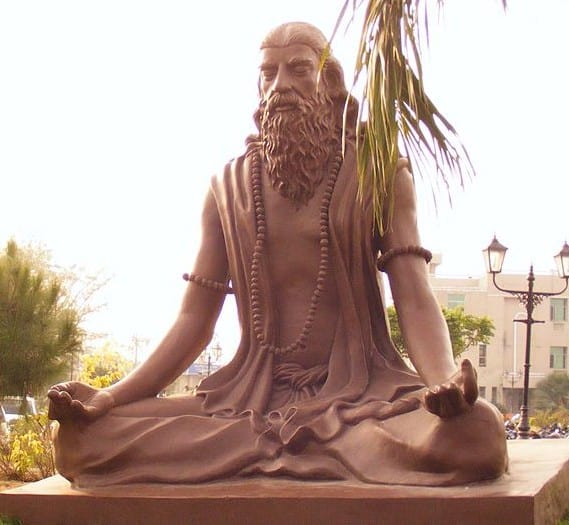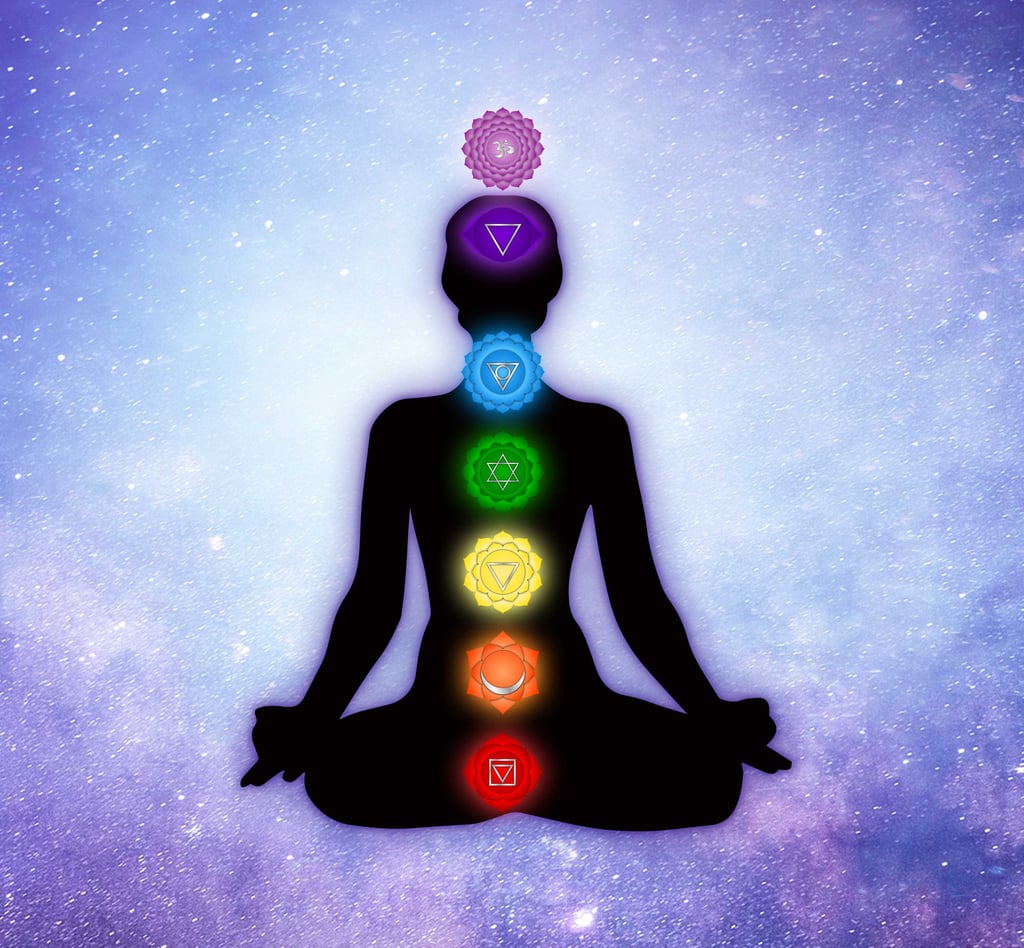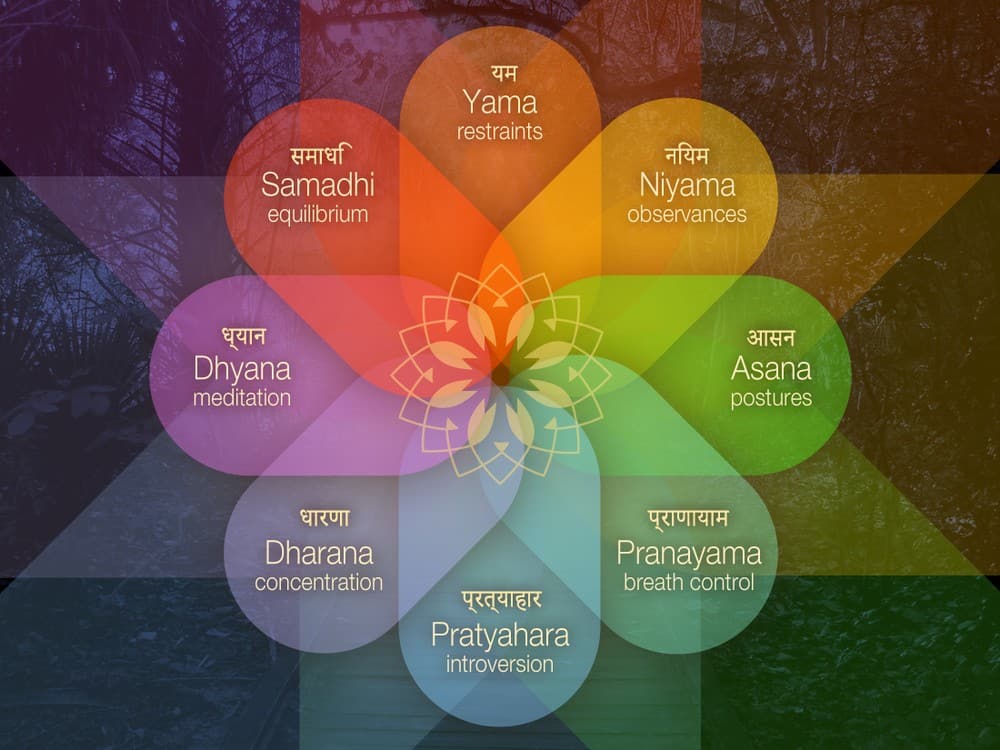Last updated on March 21st, 2024 at 03:34 pm
What are the 8 Limbs of Yoga?
Table of Contents
Yoga is an ancient practice that extends far beyond the physical poses most commonly associated with it. At the heart of yoga lies a profound philosophy known as the 8 Limbs of Yoga (or Ashtanga Yoga). These eight interconnected principles, outlined in the Yoga Sutras by the sage Patanjali, offer a comprehensive framework for living a more balanced, meaningful, and ultimately enlightened life.
Whether you’re a seasoned yogi or just beginning your exploration, understanding the 8 Limbs can deepen your practice and unlock a greater sense of well-being. By cultivating these aspects on and off the mat, you embark on a journey of self-discovery, inner peace, and transformation.
So, what exactly are these 8 Limbs?
Yama (Ethical Standards): Think of these as your moral compass. They include things like non-violence, truthfulness, not stealing, moderation, and non-attachment.
Niyama (Personal Observances): This is about self-discipline and covers ideas like cleanliness, contentment, self-study, and a sense of devotion.
Asana (Physical Postures): Here’s the part most people associate with yoga – the poses! They build strength, flexibility and prepare us for deeper practices.
Pranayama (Breath Control): Special breathing techniques that calm the mind and bring benefits to our overall health.
Pratyahara (Sense Withdrawal): Learning to tune out distractions and turn our focus inward.
Dharana (Concentration): Focusing your mind on a single thing – it takes practice!
Dhyana (Meditation): Deepening focus into a state of stillness and peace.
Samadhi (Enlightenment): A state of unity and understanding your true nature. This is the ultimate goal for some practitioners.

So why? And where did the 8 Limbs of Yoga all begin?
To embrace a true yogic lifestyle, we must delve into the 8 Limbs of Yoga – the essence of this ancient practice. Outlined by the sage Patanjali in his seminal work, the Yoga Sutras, this eightfold path offers a framework for self-understanding and inner peace.
The 8 Limbs were designed to quiet the mental chatter that obscures our experience of life. While asanas (yoga poses) focus on the physical body, the 8 Limbs address deeper transformation, offering tools to manage our senses and cultivate inner strength.
Practicing this eightfold path can lead to:
- Enhanced insight, intuition, and self-awareness
- Inner balance amidst life’s challenges
- Increased resilience and fortitude

Patanjali: Systematizing Yoga
The revered sage Patanjali compiled the Yoga Sutras, outlining a comprehensive guide to psychological transformation through yoga. This collection of 195 wisdom verses (sutras) addresses the big picture of yoga and offers a roadmap for a meaningful life. His teachings form the foundation of Classical Yoga.
Of the 195 sutras, 31 focus on the 8 Limbs, also known as Ashtanga Yoga (“Ashta” meaning eight, “anga” meaning limb). They’re also termed Raja Yoga (“Royal Yoga”), emphasizing self-mastery and control of our inner world. The 8 Limbs guide us from external concerns to profound inner exploration – the key to lasting change and liberation, according to Patanjali. The first four limbs are outwardly focused while the last four are internally focused.
What Are Yamas and Niyamas?
Yamas and Niyamas form the ethical foundation of yoga. These moral guidelines and personal observances were traditionally considered the most important aspects, shaping how we interact with the world and ourselves. While commonly thought of as just physical postures, true yoga begins with these vital principles.
Understanding Yamas and Niyamas empowers us to direct our energy positively and authentically. Sadly, many modern yoga contexts overlook these foundational elements, focusing solely on the physical aspect (asanas).
The Yamas
The Yamas, the first limb of Patanjali’s 8 Limbs of Yoga, act as a guide for ethical conduct and fostering harmonious relationships with the world around us. They emphasize the cultivation of self-discipline and mindful actions, laying the groundwork for a purposeful life and the journey toward inner peace. These ethical principles serve as a foundation for the later limbs of yoga, guiding us inward as we refine our focus and cultivate meditation practices. Let’s delve deeper into each Yama and how we can apply these ancient principles to navigate the complexities of modern life.
1. Ahimsa: The Foundation of Compassion and Non-Harming
Ahimsa, the first of the Yamas, translates to “non-violence” or “non-harming.” It’s a fundamental principle in yoga that guides us toward compassionate living and minimizing harm to ourselves and all beings. Ahimsa extends far beyond physical actions – it’s about cultivating kindness in thoughts, words, and deeds, promoting peace in all our interactions.
Applying Ahimsa in Daily Life
- Mindful Communication: Choosing words that uplift rather than harm.
- Conscious Choices: Considering the impact of our lifestyle choices on the environment and other living beings (a plant-based diet is one example).
- Inner Peace: Practicing self-care and avoiding things that harm ourselves mentally or physically.
- Broader Perspective: Recognizing the interconnectedness of all life and acting in ways that support the well-being of the whole.

2. Satya: Cultivating Truthfulness and Authenticity
Satya, the second Yama, embodies the principles of truthfulness, honesty, and living in alignment with our own inner truth. It’s about being authentic in our thoughts, words, and actions, avoiding any form of deception towards ourselves or others.
Living in Satya
- Mindful Speech: Communicating with honesty and clarity, without exaggeration or misleading others.
- Self-Awareness: Recognizing both our strengths and areas for growth without self-delusion.
- Integrity: Aligning our inner beliefs with our outer actions.
- Openness: Being receptive to constructive feedback rather than becoming defensive.
- Accountability: Taking responsibility and making amends when our actions go astray.
3.Asteya: Non-Stealing, Cultivating Contentment
Asteya, the third Yama, translates as “non-stealing” but carries deeper implications of non-greediness and respect for what belongs to others. It goes beyond physical possessions – it’s about respecting intellectual property, avoiding taking credit for another’s efforts, and cultivating a sense of “enoughness.”
Asteya in Action:
- Respecting Ownership: Not taking what isn’t ours, on physical, intellectual, and emotional levels.
- Contentment: Finding joy in what we already have and avoiding constant comparison.
- Conscious Consumption: Considering social and environmental impact alongside personal desires.
- Gratitude: Appreciating our blessings and avoiding a sense of entitlement.
4. Brahmacharya: Mindful Energy Management
Brahmacharya, the fourth Yama, is often translated as “celibacy,” but its significance extends far beyond that, to the conscious use of our vital energy. This principle encompasses mindful management of our creative energy, including, but not limited to, our sexuality.
What Brahmacharya Encompasses:
- Self-Mastery: Cultivating discipline over impulses and finding balance instead of extremes.
- Respectful Relationships: Ensuring all interactions, whether sexual or not, honor consent and boundaries.
- Focus and Vitality: Channeling energy towards personal growth, creativity, or spiritual goals.
- Healthy Boundaries: Avoiding overindulgence of any kind that drains us or distracts from our purpose.
5. Aparigraha: Freedom Through Non-Attachment
Aparigraha, the final Yama, translates to “non-attachment” or “non-possessiveness.” It’s about cultivating freedom from clinging to material objects, specific outcomes, or even our own self-image. Aparigraha doesn’t imply abandoning worldly life, but rather finding peace within change and appreciating the impermanence of all things.
Living Aparigraha:
- Letting Go: Releasing the need to control or possess things beyond what’s truly needed.
- Contentment: Finding joy in the present moment and what we already have.
- Adaptability: Embracing change without becoming overly attached to specific outcomes.
- Inner Peace: Cultivating calmness amidst life’s fluctuations.
Aparigraha’s Modern Relevance
In today’s world of constant stimulation and messages urging acquisition, Aparigraha is an especially vital principle. It allows us to step outside the cycle of endless desire and find true contentment.
Practicing the Yamas offers far more than individual benefits. By cultivating non-violence, truthfulness, non-stealing, moderation, and non-attachment, we lay the foundation for a more compassionate and just society, one where respect for others and peaceful resolution of conflict become the norm.
While often associated with yoga and spiritual practices, the Yamas have universal relevance. They offer a guide for ethical conduct in all areas of life – our workplaces, our relationships, and our interactions with the natural world.
The Yamas provide a powerful framework for living with integrity and cultivating deeper self-awareness. By embracing these principles, we take a step toward creating a more harmonious world, while also fostering greater inner peace and a sense of interconnectedness.

The Niyamas
The Niyamas, the second limb of Patanjali’s 8 Limbs of Yoga, act as a guide for cultivating inner discipline and self-awareness. Unlike the Yamas, which focus on our interactions with the world, the Niyamas are about developing a strong personal foundation. These practices of self-study and refinement offer a pathway toward greater personal growth, self-understanding, and a deeper connection to ourselves and something larger. Let’s dive into each Niyama and see how they can be integrated into our modern world.
1. Saucha: Cultivating Purity Within and Without
Saucha, the first Niyama, emphasizes both inner and outer cleanliness or purity. It extends far beyond physical hygiene – it encompasses our thoughts, emotions, and the environments we create for ourselves.
Practicing Saucha
- Physical Cleanliness: Good hygiene, a nourishing diet, and healthy habits for the body.
- Mental Clarity: Cultivating positive thoughts, releasing negativity, and practicing mindfulness.
- Environmental Purity: Maintaining a clean and organized living space.
- Spiritual Cleanliness: Letting go of limiting beliefs or self-judgment that might impede inner peace.
2. Santosha: Finding Contentment and Gratitude
Santosha, the second Niyama, is about cultivating contentment, satisfaction, and a deep appreciation for what we have in the present moment. It doesn’t mean ignoring desires or passively accepting life, but rather finding joy within ourselves rather than through endless external pursuits.
Santosha in Action:
- Appreciative Mindset: Focusing on blessings instead of what’s lacking.
- Letting Go of Comparison: Avoiding the trap of measuring our worth against others.
- Inner Abundance: Recognizing that true fulfillment comes from within.
3. Tapas: Discipline and Inner Strength
Tapas, the third Niyama, translates to “discipline” or “heat” – representing the focused effort needed for self-transformation. It’s about cultivating willpower and perseverance to overcome challenges. Tapas doesn’t imply harsh austerity, but rather a sustained effort towards our goals.
Living with Tapas
- Dedication to Practice: Maintaining consistent effort in yoga or other personal growth practices.
- Resisting Temptation: Overcoming habits or impulses that impede our goals.
- Mental Focus: Developing the tenacity to stay on track amidst difficulties.
The practice of Tapas involves setting clear intentions and goals, and developing the discipline and focus to follow through on them. It also involves cultivating the ability to delay gratification and resist temptation, and to make choices that are aligned with our values and principles.

4. Svadhyaya: The Path to Self-Knowledge
Svadhyaya, the fourth Niyama, means “self-study” or “self-reflection.” It encourages us to embark on a journey of inward discovery, cultivating a deep understanding of our thoughts, motivations, patterns, and true nature. With greater self-awareness, we can make choices more aligned with our authentic selves.
Svadhyaya Practices
- Mindful Introspection: Observing our thoughts, feelings, and behaviors without judgment.
- Meditation: Cultivating stillness to gain greater self-awareness.
- Journaling: Writing as a tool for self-exploration and understanding.
- Honest Reflection: Asking ourselves challenging questions about our habits and beliefs.
- Spiritual Inquiry: This could include studying sacred texts or exploring your personal concept of the divine.
5. Ishvara Pranidhana: Surrendering to Something Greater
Ishvara Pranidhana, the final Niyama, translates as “surrender to a higher power.” It’s about releasing the ego’s tight grip, trusting in a greater force, and recognizing our place within a vast interconnected universe. This doesn’t necessarily imply a specific religious belief, but rather cultivating faith in a guiding force beyond ourselves.
Ishvara Pranidhana in Practice
- Humility: Recognizing our limitations and the interconnectedness of all things.
- Letting Go: Releasing attachment to specific outcomes or our own need for control.
- Openness: Embracing life’s unfolding with a sense of trust.
- Devotion: Cultivating a connection to something larger – this could be a traditional deity, nature, or a sense of universal love.
By integrating the Niyamas into our daily lives, we tap into a profound source of self-awareness, personal growth, and a deeper sense of purpose. Remember, the Niyamas aren’t meant to be rigid rules, but rather adaptable practices that support our unique journey.
Saucha promotes inner and outer cleanliness for greater clarity and well-being. Santosha fosters contentment, helping us find joy in the present moment. Tapas builds discipline and resilience when facing challenges. Svadhyaya opens doors to self-knowledge, guiding us towards authenticity. Ishvara Pranidhana cultivates humility and connection to something greater than ourselves.
The Niyamas offer a life-changing toolkit for fostering inner growth and harmony. By embracing these practices, we cultivate a more fulfilling existence, deeply connected to both ourselves and the wider world.

Asana: The Physical Foundation of Yoga
Asana, the third limb of the 8 Limbs of Yoga, encompasses the physical postures often associated with modern yoga practice. However, it’s important to remember that asana is far more than just exercise – it’s a foundational component of a holistic system designed to foster well-being on all levels.
The Origins of Asana
The Sanskrit word “asana” translates to “seat” or “posture.” Originally, it primarily referred to seated positions for meditation. Over time, the term evolved to include the wide variety of dynamic postures we practice today – standing poses, forward bends, twists, backbends, inversions, and arm balances.
Benefits of Asana Practice
The focus on proper alignment, mindful movement, and breath control in asana practice offers a multitude of benefits that extend beyond the physical body:
- Physical: Asana practice strengthens and tones muscles, improves flexibility and range of motion, enhances balance and coordination, and increases stamina and endurance.
- Mental: Holding a pose while focusing on the breath can cultivate mental clarity, improve focus and concentration, and promote relaxation and stress reduction. Asana practice can also boost mood and feelings of well-being.
- Emotional: Yoga postures can be a powerful tool for developing self-awareness and emotional regulation. Holding a challenging pose and working through discomfort can build mental resilience and emotional grit.
- Holistic: Asana practice can be a doorway to deeper self-discovery and a more profound connection with the mind, body, and spirit. It can also serve as a tool for healing and rehabilitation, promoting overall health and well-being.

Sthira Sukham Asanam: Finding Balance
This key principle translates as “steady and comfortable posture.” It encourages finding a balance between effort and relaxation in each pose. This mindful approach helps cultivate body awareness, breath control, and inner stillness.
Beyond the Physical
While asana offers significant benefits, true yoga integrates all eight limbs. Combining asana with practices like meditation, breathwork, and ethical living deepens the experience and potential for transformation.
Safety and Self-Awareness
Asana should always be practiced with respect for your body’s unique needs and limitations. It’s about personal exploration, not competition or striving for external ideals. Listen to your body’s signals, and don’t hesitate to modify poses or use props as needed. A qualified yoga teacher can help you develop a safe and effective practice that aligns with your goals and abilities.
Pranayama: Harnessing the Power of Breath
Pranayama, the fourth limb of the 8 Limbs of Yoga, encompasses the conscious control of the breath for physical, mental, and spiritual well-being. The Sanskrit word “prana” means “life force” or “vital energy,” while “ayama” translates to “extend” or “control.” This highlights the profound potential of Pranayama to enhance energy flow and overall health.
Pranayama Techniques
Various Pranayama techniques exist, each with unique benefits:
- Deep Breathing: Simple yet powerful, deep abdominal breathing promotes relaxation and can increase oxygen intake.
- Alternate Nostril Breathing (Nadi Shodhana): Balances the flow of energy through the subtle energy channels (nadis). Promotes calmness and clarity.
- Breath Retention (Kumbhaka): Carefully practiced pauses after inhalation or exhalation can enhance benefits and deepen practice.


Benefits of Pranayama
- Reduced Stress & Anxiety: Controlled breathing can slow heart rate, lower blood pressure, and promote relaxation.
- Enhanced Focus & Mindfulness: Conscious breathwork improves concentration and cultivates present-moment awareness.
- Improved Respiratory Health: Pranayama can strengthen respiratory muscles, increase lung capacity, and benefit conditions like asthma or COPD.
- Energetic Balance: Pranayama helps regulate and balance the flow of prana, improving overall vitality and well-being.
How to Practice Pranayama
- Start Slowly: Beginners should start with simple techniques and gradually increase intensity.
- Comfortable Setting: Find a quiet, undisturbed location.
- Mindful Approach: Practice with patience and self-awareness, respecting your body’s signals.
- Post-Meal Caution: Avoid practicing on a full stomach.
Holistic Approach
Pranayama shines brightest when combined with other aspects of yoga like Asana (postures), meditation, and ethical living. This integrated approach leads to transformative benefits for mind, body, and spirit.

Pratyahara: Turning Inward for Clarity and Focus
Pratyahara, the fifth limb of the 8 Limbs of Yoga, translates as “withdrawal of the senses,” directing our attention inward rather than getting caught up in the constant stream of external stimulation. This practice cultivates self-awareness, mental focus, and prepares us for deeper meditative states.
Why Pratyahara Matters
Our minds are often pulled in countless directions by our sights, sounds, smells, tastes, and touch. Pratyahara trains us to become the masters of our focus, reducing distraction and facilitating profound inner exploration. This is especially important for anyone preparing for meditation or seeking a deeper connection with their true selves. Think of your mind as a beautiful garden. Without tending to it, weeds of external stimuli can quickly take over, choking out the delicate flowers of your thoughts and inner experiences. Pratyahara equips you with the tools to clear away these weeds and cultivate a flourishing garden of self-awareness.
Techniques for Practicing Pratyahara
- Sensory Management: Reducing external stimuli can be as simple as closing your eyes or finding a quiet space. More advanced techniques might involve sensory deprivation tanks, which provide a completely lightless and soundproof environment. However, such techniques are not essential for beginners. Even small steps like turning off your phone notifications or practicing in a room with minimal clutter can create a more conducive environment for Pratyahara.
- Visualization: Focusing the mind on a specific image, object, or concept helps quiet external distractions. Guided imagery can be a powerful tool for beginners. Imagine yourself in a peaceful place, perhaps a quiet forest or a calming beach. Engage all your senses in this visualization – listen to the sounds of nature, feel the warmth of the sun on your skin, smell the fresh air. The more vivid your visualization, the more effectively it can cut through external noise and bring your focus inward.
- Meditation: Perhaps the most potent practice for Pratyahara, meditation trains us to observe our thoughts and sensations without getting swept away by them. Options like breath focus or mantra meditation can be helpful. As you sit in meditation, inevitably your mind will wander – that’s perfectly normal! The key is to gently guide your focus back to your breath or mantra without judgment. Over time, with consistent practice, you’ll find it easier to maintain your focus and cultivate a deeper state of inner calmness.

Pratyahara is an essential component of the eight limbs of yoga, and is a powerful tool for cultivating self-awareness, mental clarity, and inner peace. Through the practice of Pratyahara, we can learn to control the senses and withdraw from the distractions of the external world, in order to focus on the inner experience of the self. While Pratyahara can be a challenging practice, with regular practice and dedication, it can help to promote greater physical, mental, and spiritual health and well-being.
Dharana: Sharpening Your Mental Focus
Dharana, the sixth limb of the 8 Limbs of Yoga, translates to “concentration” or “one-pointed focus.” It’s about training the mind to anchor itself on a single object, thought, or sensation, cutting through the constant mental chatter. Dharana lays the groundwork for deep meditative states and brings greater clarity and control to our everyday lives.
Techniques for Practicing Dharana
Breath Awareness: A simple yet powerful starting point. Observe the natural flow of your breath, noticing its rhythm and sensations. When your mind wanders, gently bring it back to the breath. This practice cultivates present-moment awareness, a key skill for navigating the distractions of daily life.
Visualization: Focus intensely on a specific image or object. This could be a candle flame, a geometric shape, or a calming nature scene. Let the image fill your mind, pushing out other thoughts. Visualization can be a powerful tool for relaxation and stress management. Imagine yourself in a peaceful place, and allow the sights, sounds, and sensations of that environment to wash over you.
Mantra Meditation: The repetition of a word or phrase (mantra) can quiet the mind and promote focus. Choose a mantra that resonates with you and repeat it silently, letting it anchor your attention. Mantras can be simple sounds, such as “Om,” or Sanskrit phrases with deeper meanings. Experiment and find what resonates most with you.
Trataka (Candle Gazing): This technique involves fixing your gaze upon an external object, commonly a candle flame, to cultivate single-pointed attention and focus. As you hold your gaze, the flame can become a mesmerizing focal point, drawing your attention inward and reducing external distractions. Trataka is a powerful tool for developing mental discipline and strengthening willpower.


The Essence of Dharana
Regardless of the technique, the key is to hold your chosen focus with unwavering attention. It’s natural for the mind to wander, especially at first. The practice lies in gently redirecting your focus without frustration or judgment. Think of it like building mental muscle – with repetition comes greater strength. Over time, you’ll find it easier to maintain focus not just during your Dharana practice, but also in your daily activities and relationships.
Benefits of Dharana
Enhanced Concentration: Develops the ability to direct your attention at will, improving focus in all areas of life, from work tasks to creative pursuits.
Reduced Mental Noise: Quiets the constant stream of thoughts, promoting inner peace and calmness. This can significantly reduce stress and anxiety, leading to a greater sense of well-being.
Self-Mastery: Increases control over the mind, reducing reactivity to external triggers. By learning to focus your attention, you become less susceptible to distractions and emotional impulses.
Preparation for Meditation: Dharana is like the ‘warm-up” before diving deeper into meditation practices. By training your mind to focus and let go of distractions, you prepare yourself for the deeper stillness and insights that meditation can offer.
Dharana in Everyday Life
The benefits of Dharana extend far beyond the yoga mat. By strengthening your ability to focus and concentrate, you can enhance your performance in various aspects of your life:
Improved Work Performance: Enhanced focus translates to better productivity and reduces the likelihood of errors or procrastination.
Creative Problem-Solving: Dharana allows you to delve deeper into complex problems, fostering innovative solutions and critical thinking skills.
Stronger Relationships: By being more present and focused during interactions, you can cultivate deeper connections with loved ones and colleagues.
Greater Self-Awareness: Dharana can be a gateway to self-discovery. As you learn to quiet the mind, you gain a clearer understanding of your thoughts, emotions, and motivations.
Dharana empowers you to approach life with greater intention and focus. By training your mind to be less scattered and more present, you can unlock a greater sense of peace, purpose, and well-being in all areas of your life.

Dhyana: The Heart of Meditation
Dhyana, the seventh limb of the 8 Limbs of Yoga, translates to “meditation” or “contemplation.” It builds upon the foundation of Dharana (concentration), taking your focused awareness to the next level. In Dhyana, your mind becomes fully absorbed in the object of meditation, promoting a state of profound stillness, clarity, and connection.
Entering the State of Dhyana
Beyond Concentration: While Dharana involves holding a single point of focus, Dhyana is about merging with that focus. The distinction between the observer and the observed begins to dissolve, leading to a sense of flow and effortless awareness. Unlike Dharana, where you might consciously bring your attention back if it wanders, in Dhyana, the absorption is so complete that the mind naturally settles into a state of focused stillness.
Techniques: The same techniques used in Dharana (breath awareness, visualization, mantra) can lead to Dhyana with sustained practice. However, in Dhyana, the effort of focusing lessens as you become completely immersed in the present moment. The focus becomes effortless, and thoughts arise and fade away without interrupting the state of meditative absorption.
Benefits of Dhyana
Deep Relaxation: Dhyana induces a profound state of physical and mental rest, combating stress and promoting overall health. Studies have shown that regular meditation practice can lower blood pressure, improve sleep quality, and boost the immune system.
Mental Clarity: Regular practice of Dhyana sharpens focus, improves memory, and enhances cognitive function. By quieting the mental chatter and enhancing concentration, Dhyana allows you to approach tasks with greater clarity and efficiency.
Emotional Balance: Dhyana fosters inner peace, reduces anxiety, and helps manage emotional reactivity. Through meditation, you develop the ability to observe your emotions with detachment, rather than getting swept away by them. This allows for more mindful responses to challenging situations.
Self-Discovery: By quieting the internal chatter, Dhyana offers a window into your true self, cultivating greater self-awareness. As the mind settles, you begin to see your thoughts, emotions, and patterns more clearly. This self-awareness empowers you to make conscious choices and live a more fulfilling life.
Spiritual Connection: The experience of stillness and interconnectedness in Dhyana can lead to a deeper sense of connection to something larger than yourself. This spiritual connection can bring a sense of peace, purpose, and belonging.

Popular Dhyana Practices
Mindfulness Meditation: Focuses on non-judgmental observation of thoughts, sensations, and emotions, promoting acceptance and present-moment awareness. Mindfulness meditation is a great starting point for beginners and can be practiced anywhere, anytime.
Transcendental Meditation (TM): Uses a personalized mantra to quiet the mind. TM’s structured approach and association with an organization might appeal to some, but it’s important to note that other meditation techniques are equally valid. There are many different meditation traditions, each with its own unique approach. Experiment to find what resonates with you.
Guided Visualization: Using your imagination to create vivid mental imagery can deepen focus and induce relaxation. Guided meditations can be a helpful tool for beginners or those who find it challenging to focus on their breath or a mantra.
Other Forms: Numerous meditative traditions offer unique techniques for entering Dhyana. Explore different practices to find what resonates with you. Whether you prefer a silent meditation retreat or a guided meditation app, there’s a Dhyana practice suitable for your needs and preferences.
Dhyana in Everyday Life
The benefits of Dhyana extend beyond your meditation cushion. It cultivates an inner calmness and clarity that helps you navigate life’s challenges with greater mindfulness and resilience. By developing a regular meditation practice, you can bring the peace and focus you experience in Dhyana into your daily life.
Tips for Practice
- Consistency: Regular practice is key for deepening your experience of Dhyana. Aim for short meditation sessions daily, even if it’s just for a few minutes.
- Dedicated Space: Create a quiet environment for undisturbed meditation. Find a comfortable position where you can sit or lie down without distractions.
- Guidance: A qualified teacher can offer personalized instruction and support, especially for beginners. There are also many online resources and meditation apps available to guide you on your meditation journey.
Samadhi: Enlightenment and the Culmination of Yoga
Samadhi, the eighth and final limb of the 8 Limbs of Yoga, signifies the pinnacle of the yogic journey. It’s a state of complete absorption, where individual consciousness dissolves, leading to a profound sense of unity with the universe. In this state of pure awareness, the mind transcends limitations, bringing unparalleled peace, bliss, and understanding.
The Meaning of Samadhi
The Sanskrit word “Samadhi” translates to “bringing together” or “integration.” It reflects the merging of all aspects of the self, leaving behind distractions and the limitations of the ego. Imagine your being like the ocean: Samadhi is not a single wave, but the experience of the ocean’s vastness, where the sense of separate self dissolves.


The Path to Samadhi
Samadhi is considered the ultimate goal of yoga, and the culmination of the 8-fold path. Mastery over the preceding limbs – from ethical living (Yamas, Niyamas) to physical postures (Asanas) and meditation (Dhyana) – lays the foundation for this transcendent state. Samadhi cannot be forced through willpower; it arises naturally when the mind achieves perfect stillness.
Types of Samadhi
Savikalpa Samadhi: A meditative state characterized by deep oneness with the object of meditation, while still retaining some awareness of the external world and subtle sense of self. This state can offer glimpses of the unity that lies beyond individuality and can be accompanied by feelings of profound peace and joy.
Nirvikalpa Samadhi: The highest level of Samadhi, marked by complete absorption with no remaining sense of self or separation from the divine. This profound experience is said to bring ultimate bliss, wisdom, and liberation from the cycle of suffering.
Experiencing Samadhi
Reaching Samadhi takes dedication and surrender. Yogic practices must be approached consistently, along with cultivating devotion and humility. While the pinnacle of yoga, moments of Samadhi can be experienced in other areas of life. Moments of deep flow or complete absorption, whether in music, art, even daily tasks, offer a taste of this state of boundless awareness. Think of a scientist completely engrossed in a groundbreaking discovery, or an athlete in the zone during a peak performance. These states of deep concentration and oneness with the activity at hand mirror the experience of Savikalpa Samadhi.
Benefits of Samadhi
The yogic tradition describes the attainment of Samadhi as life-changing, bringing:
- Unwavering Peace: A profound stillness that transcends everyday worries and anxieties.
- Boundless Joy: A pervasive sense of contentment and well-being.
- Deep Understanding: Insight into the interconnected nature of all things.
- Transformation: The experience fosters positive change, both within and in interactions with the world.
Samadhi and Everyday Life
While Samadhi is the pinnacle, the journey through the 8 Limbs is equally valuable. Each step cultivates mindfulness, self-awareness, and inner harmony. The goal is not simply to reach a temporary state, but to live with greater presence and purpose, moment by moment. Samadhi offers a glimpse of our full potential, reminding us of the profound peace, joy, and interconnectedness that lie within us all. Even if we never reach the heights of Nirvikalpa Samadhi, the practices that lead us there can enrich our lives in countless ways.

The 8 Limbs of Yoga offer a transformative journey of self-discovery, ethical living, and connection. Each limb builds on the next, guiding us from ethical principles (Yamas, Niyamas) to physical practice (Asana), breathwork (Pranayama), and inward focus (Pratyahara, Dharana, Dhyana). While Samadhi (enlightenment) is the ultimate goal, the profound benefits lie in each step.
Yoga is a practice, not a destination. Embrace the 8 Limbs as a map for personal growth, and start wherever you feel called. Whether it’s a yoga class, breathwork exercises, or simply reflecting on ethical conduct, the 8 Limbs offer a path toward a more mindful, fulfilling life.
